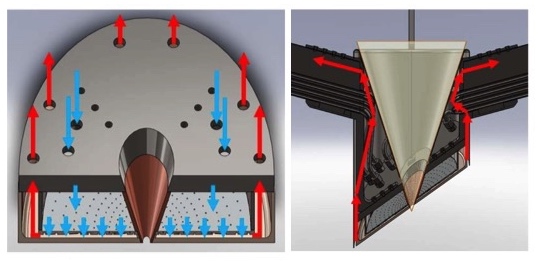Heat Rejecter

The Heat Rejecter (HR) lies at the prime focus of the telescope and operates as first field stop of the optical system. The aim of the HR is to reject the solar radiation falling outside the selected Field Of View, avoiding the development of thermal plumes, i.e. avoiding internal seeing.
The science requirements state that observations up to a distance of 100 arcsec from the solar limb should be possible. Various concepts have been analyzed to meet the requirement and a system based on rejecting the heat (heat rejecter) is preferred to a technology based on absorbing the heat (heat trap, heat absorber or heat rejecter), since it is the most suitable for the telescope configuration. A heat rejecter shall dissipate less than 10% of the heat compared to a heat absorber; it is also smaller and totally compatible to an open air telescope configuration.
The solar radiation, in the optical layout of the telescope, generates a total thermal load on the heat rejecter of about 13.5 kW assuming a ~95% reflectivity for the primary mirror (M1). The M1 has a diameter of 4.2 m with a central hole of 1.3 m and a focal length of about 6.3 m. Accordingly, the sun image size at the focal plane is about 60 mm and the heat load ranges between 2000 W and 700 W, for an HR surface reflectivity of 85% and 95%, respectively.
The cooling system required to remove the HR thermal load shall be designed to avoid the formation of air turbulence in the optical path due to the temperature increment on the HR heated surface. Due to the large heat load applied on the HR heated surface and its critical location, the cooling system shall be study carefully and if necessary backed up by an air suction system to avoid hot air plumes at any time.
At the end of this stage, the HR design and specifications will be consolidated, allowing starting the detailed design and construction of this subsystem.
Additional information can be found here.
